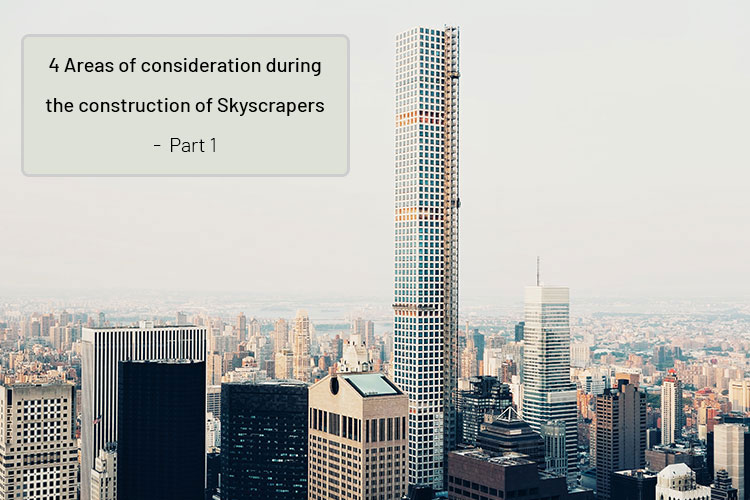4 Areas of consideration during the construction of Skyscrapers- Part 1

From the Great Pyramids and Eiffel Towers to Empire State Building and Burj Khalifa, humans have always yearned to touch the sky. Today, skyscraper is a symbol for mankind’s limitless ambition and a practical solution to accommodate more people in limited site space. Skyscrapers are goldmine of profit, they bring in tourism, have hotels, restaurants, offices and residential spaces. They have also over the years become symbolic of the country success and pride. Keeping all this in mind it comes as no surprise that architects and engineers as well as city councils are proposing skyline-defining structures.
However, to construct an operational skyscraper is no simple task because it needs to consider a variety of things like structural integrity, safety of the workers and residents, facility management etc. Below we look at the four main areas of consideration while building a skyscraper.
Table of Contents
Importance of a Solid Foundation:
The first step in the construction of a skyscraper is to find out what it will sit on top of. It could be sand, clay, rock etc. This is extremely crucial to figure out at the onset, even before the structure goes into design because on top of being tall the building is going to also be extremely heavy. A lack of solid foundation could lead to two types of adverse results; the building could either lean sideways as seen in the case of leaning tower of Pisa in Italy which sits on weak sandy soil or it could sink as in the case of Chicago’s Monadnock building which has due to its swampy, soft ground has sunk by 21 inches since 1891. It could be worse still as seen in Millennium Tower SFO that has both sunk by 18 inches and is tilting northwest in less than a decade since its construction.
The skyscrapers are extremely heavy and in most cases the base of the structure carries the weight of the whole building. However, today the engineers and designers have ways to tackle the challenge of inadequate ground conditions. They can here create a raft foundation, which is a reinforced concrete slab under the whole building. It floats on the ground as a raft floats on water allowing to spread the load of the building over a larger area than conventional foundations ultimately lowering the pressure on ground. BIM Services today can use software like Revit has the option to create a DTM (Digital Terrain Model) which shows the bare ground surface area and can be used for effective planning, visualization, height analysis, sight lines etc. before actually going ahead with the construction.
Dealing with Climatic Conditions and Natural Factors:
Whenever a skyscraper equivalent to the height of the Burj Khalifa or Shanghai Tower is being constructed the engineers and architects must take into account various factors. The structure must have the ability to deal with excessive temperature, earthquakes, lightning etc. However, the biggest challenge that it must address is high winds which could pose a serious danger to the structure. The classic shape of the skyscraper which is a rectangular face is a disaster waiting to happen from an aerodynamic perspective. When the wind pushes against a building which has a constant dimension from top to bottom it creates vortexes. These vortexes basically create low pressure regions that push or suck on the building causing it to shake and sway.
There are two ways to reduce the sway. One way is that a very tall weight is hoisted at the top of a building in a kind of a sling. It was designed to counterbalance any movement in the building. It is called a mass damper and it has been with great success used in Taipei 101. However, one problem is that it consumes a lot of space. One another ingenious way of reducing the sway was used by the engineers in designing Burj Khalifa where in the building was reshaped to deal with the forces of the wind. The Burj has an unusual cross section that rotates and changes the size as the building moves up. There is no single face runs that entire height. This way when the wind hits the Burj it reacts with different levels in different ways. This unique design ensures that instead of having one massive vortex that exerts a huge force there are several smaller forces acting on building reducing the pressure.
In the part 1 of this article we looked at the importance of solid foundation for construction of skyscrapers and how to deal with the climatic conditions which could have adverse consequences during the building’s lifecycle. In the following article we will be looking into the challenge posed by MEP systems and how MEP BIM Services provide solutions as well as look at the necessity of virtual construction for proper designing, construction and maintenance of skyscrapers.